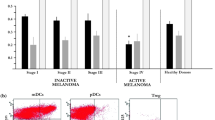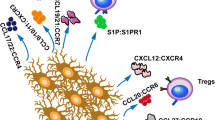Abstract
Background
Immunologic therapies for melanoma rarely succeed, suggesting a persistent counter-regulatory immune modulation. Regulatory T cells (Tregs) and plasmacytoid subpopulations of dendritic cells (pDCs) inhibit the immune response. We hypothesize that melanoma upregulates Tregs and subpopulations of immunosuppressive dendritic cells (DCs).
Methods
Peripheral blood mononuclear cells (PBMCs) were obtained from healthy controls, stage I and stage IV melanoma patients. Tregs were identified as CD4+ and CD25hi. Dendritic cells were identified using a DC cocktail of antibodies including CD11c+ myeloid dendritic cells (mDCs) and CD123+ pDCs. Serum transforming growth factor-β (TGF-β), interleukin-4 (IL-4) and interleukin-10 (IL-10) levels were determined by enzyme-linked immunosorbent assay (ELISA). Statistical analysis was performed using analysis of variance (ANOVA).
Results
Stage IV melanoma patients had a doubling of regulatory T cells compared to both normal subjects and stage I melanoma patients. There was a significantly higher number of DCs in all melanoma patients compared to normal subjects. Stage I melanoma patients had a significantly higher number of pDCs than normal subjects, and all melanoma patients had a higher concentration of mDCs than controls. Serum IL-4 and IL-10 were not detectable but serum TGF-β levels were significantly higher in stage I and stage IV melanoma patients compared to normal controls.
Conclusion
Advanced melanoma is associated with increased numbers of circulating dendritic cells and regulatory T cells. These data suggest that melanoma induces immunosuppressive DCs and regulatory T cells in the systemic circulation.




Similar content being viewed by others
References
Shu S, Plautz GE, Krauss JC, Chang AE. Tumor immunology. JAMA 1997;278(22):1972–81
Pardoll D. Does the immune system see tumors as foreign or self? Annu Rev Immunol 2003;21:807–39
Banchereau J, Briere F, Caux C, et al. Immunobiology of dendritic cells. Annu Rev Immunol 2000;18:767–811
Banchereau J, Palucka AK. Dendritic cells as therapeutic vaccines against cancer. Nat Rev Immunol 2005;5(4):296–306
Mellman I, Steinman RM. Dendritic cells: specialized and regulated antigen processing machines. Cell 2001;106(3):255–8
Cox K, North M, Burke M, et al. Plasmacytoid dendritic cells (PDC) are the major DC subset innately producing cytokines in human lymph nodes. J Leukoc Biol 2005;78(5):1142–52
Kuwana M. Induction of anergic and regulatory T cells by plasmacytoid dendritic cells and other dendritic cell subsets. Hum Immunol 2002;63(12):1156–63
Baecher-Allan CM, Hafler DA. Functional analysis of highly defined, FACS-isolated populations of human regulatory CD4+CD25+ T cells. Clin Immunol 2005;117(2):192; discussion 193
Sakaguchi S, Sakaguchi N, Asano M, et al. Immunologic self-tolerance maintained by activated T cells expressing IL-2 receptor alpha-chains (CD25). Breakdown of a single mechanism of self-tolerance causes various autoimmune diseases. J Immunol 1995;155(3):1151–64
Dieckmann D, Plottner H, Berchtold S, et al. Ex vivo isolation and characterization of CD4(+)CD25(+) T cells with regulatory properties from human blood. J Exp Med 2001;193(11):1303–10
Wolf AM, Wolf D, Steurer M, et al. Increase of regulatory T cells in the peripheral blood of cancer patients. Clin Cancer Res 2003;9(2):606–12
Liyanage UK, Moore TT, Joo HG, et al. Prevalence of regulatory T cells is increased in peripheral blood and tumor microenvironment of patients with pancreas or breast adenocarcinoma. J Immunol 2002;169(5):2756–61
Ichihara F, Kono K, Takahashi A, et al. Increased populations of regulatory T cells in peripheral blood and tumor-infiltrating lymphocytes in patients with gastric and esophageal cancers. Clin Cancer Res 2003;9(12):4404–8
Sasada T, Kimura M, Yoshida Y, et al. CD4+CD25+ regulatory T cells in patients with gastrointestinal malignancies: possible involvement of regulatory T cells in disease progression. Cancer 2003;98(5):1089–199
Curiel TJ, Coukos G, Zou L, et al. Specific recruitment of regulatory T cells in ovarian carcinoma fosters immune privilege and predicts reduced survival. Nat Med 2004;10(9):942–9
Appay V, Jandus C, Voelter V, et al. New generation vaccine induces effective melanoma-specific CD8+ T cells in the circulation but not in the tumor site. J Immunol 2006;177(3):1670–8
Viguier M, Lemaitre F, Verola O, et al. Foxp3 expressing CD4+CD25(high) regulatory T cells are overrepresented in human metastatic melanoma lymph nodes and inhibit the function of infiltrating T cells. J Immunol 2004;173(2):1444–53
Javia LR, Rosenberg SA. CD4+CD25+ suppressor lymphocytes in the circulation of patients immunized against melanoma antigens. J Immunother 2003;26(1):85–93
Cesana GC, DeRaffele G, Cohen S, et al. Characterization of CD4+CD25+ regulatory T cells in patients treated with high-dose interleukin-2 for metastatic melanoma or renal cell carcinoma. J Clin Oncol 2006;24(7):1169–77
Chattopadhyay S, Chakraborty NG, Mukherji B. Regulatory T cells and tumor immunity. Cancer Immunol Immunother 2005;54(12):1153–61
Becker JC, Schwinn A, Dummer R, et al. Tumour-infiltrating lymphocytes in primary melanoma: functional consequences of differential IL-2 receptor expression. Clin Exp Immunol 1993;91(1):121–5
Ahmadzadeh M, Rosenberg SA. IL-2 administration increases CD4+ CD25(hi) Foxp3+ regulatory T cells in cancer patients. Blood 2006;107(6):2409–14
Attia P, Maker AV, Haworth LR, et al. Inability of a fusion protein of IL-2 and diphtheria toxin (Denileukin Diftitox, DAB389IL-2, ONTAK) to eliminate regulatory T lymphocytes in patients with melanoma. J Immunother 2005;28(6):582–92
Quezada SA, Peggs KS, Curran MA, Allison JP. CTLA4 blockade and GM-CSF combination immunotherapy alters the intratumor balance of effector and regulatory T cells. J Clin Invest 2006;116(7):1935–45
Sakaguchi S. Regulatory T cells: key controllers of immunologic self-tolerance. Cell 2000;101(5):455–8
Piccirillo CA, Shevach EM. Naturally-occurring CD4+CD25+ immunoregulatory T cells: central players in the arena of peripheral tolerance. Semin Immunol 2004;16(2):81–8
Lauerova L, Dusek L, Simickova M, et al. Malignant melanoma associates with Th1/ Th2 imbalance that coincides with disease progression and immunotherapy response. Neoplasma 2002;49(3):159–66
McCarter M, Clarke J, Richter D, Wilson C. Melanoma skews dendritic cells to facilitate a T helper 2 profile. Surgery 2005;138(2):321–8
Almand B, Clark JI, Nikitina E, et al. Increased production of immature myeloid cells in cancer patients: a mechanism of immunosuppression in cancer. J Immunol 2001;166(1):678–89
Fricke I, Gabrilovich DI. Dendritic cells and tumor microenvironment: a dangerous liaison. Immunol Invest 2006;35(3–4):459–83
Onishi H, Morisaki T, Baba E, et al. Dysfunctional and short-lived subsets in monocyte-derived dendritic cells from patients with advanced cancer. Clin Immunol 2002;105(3):286–95
Wilkinson R, Kassianos AJ, Swindle P, et al. Numerical and functional assessment of blood dendritic cells in prostate cancer patients. Prostate 2006;66(2):180–92
Yanagimoto H, Takai S, Satoi S, et al. Impaired function of circulating dendritic cells in patients with pancreatic cancer. Clin Immunol 2005;114(1):52–60
Bellone G, Smirne C, Mauri FA, et al. Cytokine expression profile in human pancreatic carcinoma cells and in surgical specimens: implications for survival. Cancer Immunol Immunother 2006;55(6):684–98
Perrot I, Blanchard D, Freymond N, et al. Dendritic cells infiltrating human non-small cell lung cancer are blocked at immature stage. J Immunol 2007;178(5):2763–9
Vermi W, Bonecchi R, Facchetti F, et al. Recruitment of immature plasmacytoid dendritic cells (plasmacytoid monocytes) and myeloid dendritic cells in primary cutaneous melanomas. J Pathol 2003;200(2):255–68
Lebrecht A, Grimm C, Euller G, et al. Transforming growth factor beta 1 serum levels in patients with preinvasive and invasive lesions of the breast. Int J Biol Markers 2004;19(3):236–9
von Bernstorff W, Voss M, Freichel S, et al. Systemic and local immunosuppression in pancreatic cancer patients. Clin Cancer Res 2001;7(Suppl 3):925s–932s
Lin Y, Kikuchi S, Obata Y, Yagyu K. Serum levels of transforming growth factor beta1 are significantly correlated with venous invasion in patients with gastric cancer. J Gastroenterol Hepatol 2006;21(2):432–7
Song BC, Chung YH, Kim JA, et al. Transforming growth factor-beta1 as a useful serologic marker of small hepatocellular carcinoma. Cancer 2002;94(1):175–80
Frumento G, Piazza T, Di Carlo E, Ferrini S. Targeting tumor-related immunosuppression for cancer immunotherapy. Endocr Metab Immune Disord Drug Targets 2006;6(3):233–7
Dunnall J, Su Z, Rizzieri D, et al. Enhancement of vaccine-mediated antitumor immunity in cancer patients after depletion of regulatory T cells. J Clin Invest 2005;115(12):3623–33
Acknowledgments
This work supported in part by a 5 K12 CA86913 clinical oncology research career-development program award.
Author information
Authors and Affiliations
Corresponding author
Rights and permissions
About this article
Cite this article
McCarter, M.D., Baumgartner, J., Escobar, G.A. et al. Immunosuppressive Dendritic and Regulatory T Cells are Upregulated in Melanoma Patients. Ann Surg Oncol 14, 2854–2860 (2007). https://doi.org/10.1245/s10434-007-9488-3
Received:
Accepted:
Published:
Issue Date:
DOI: https://doi.org/10.1245/s10434-007-9488-3




